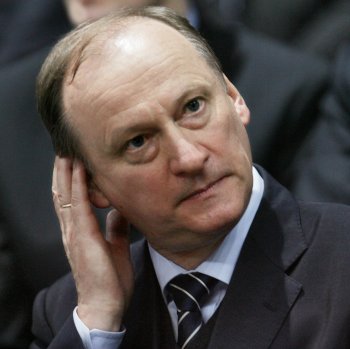
Russian Nuclear First Use: a Case of Self-Defeating Exaggeration?
Publication: Eurasia Daily Monitor Volume: 7 Issue: 7
By:

In mid-October 2009, Nikolai Patrushev, the Secretary of the Security Council, used an interview to discuss Russia’s draft military doctrine and highlighted one aspect: the first-use of nuclear weapons in a “preventive nuclear strike against the aggressor” (Izvestiya, October 14). This was not the first such declaration regarding first use by the Russia, but it came in the aftermath of the conflict with Georgia in 2008. In early December, the Russian mass media published several leaks and commentaries concerning the draft military doctrine, which, reportedly President Dmitry Medvedev would soon sign. This addressed the rationale underlying a declaratory policy of nuclear first-use in the current international environment.
The first article was critical of the declaratory policy on nuclear first use. Its author, Aleksandr Konovalov, criticized the evolution of Russian nuclear policy over the past two decades and used Patrushev’s remarks in October and those by Army-General Nikolai Makarov, the Chief of the General Staff, to foreign military attaches in December to question the utility and even the rationality of such a policy. Konovalov, the Director of the Institute of Strategic Assessments, warned that such a declaratory policy was a disaster for Russia’s position in the international community and made no political or military sense. He asserted that this element of the draft military doctrine revealed Russia to be “a power with a complex,” acknowledging the decline in Russian conventional military capabilities and the appearance of precision-strike means in the United States against which Russia has no conventional defense, and linked the ensuing declaration of nuclear first use to the military doctrine of the transition period, (the end of the twentieth century). However, the doctrinal expansion of nuclear first-use to even local conflicts amounts to an admission of an inability to find other means to deal with Russia’s security challenges. Like the hero of Chekhov’s short story, Peresolil, Russia has achieved the capacity to frighten others while harming its own interest. Declaring first use in local conflicts undermines the basic tenants of traditional nuclear deterrence as an instrument of military policy under conditions of globalization. Konovalov juxtaposed the declaration of the Federation of American Scientists on the need to adopt a minimal nuclear deterrence posture with the draft military doctrine’s attempt to expand the utility of such weapons, and called it shortsighted and counter-productive (Ogonek, December 11).
At the heart of the debate over nuclear first-use in the draft military doctrine is the contemporary threat environment confronting the Russian state. As media attention grew in December, the Academy of Military Sciences conducted its scheduled assembly. Army-General Makhmut Gareev, the President of the Academy, spoke on the trends studied by its researchers. The threat environment had shifted its center of gravity in world politics and economics to the east, and NATO’s intent to expand into the South Caucasus and Central Asian region, redirected research toward the prevention of threats. Gareev proposed moderating national interests, avoiding a “maximalist posture” because it was self-defeating. Moreover, he noted the difficulties in forecasting the military-political situation, owing to the growing dynamic of world development and that “nuclear Russia” has no declared opponents. Rather, the “adversary stays ‘in the wings’ or pretends there is a partnership” (Krasnaya Zvezda, December 16).
Two days later, Vladimir Mukhin announced the publication of a new book, addressing aspects of military threats to Russia: “Russia’s Security-2010.” The book was tied to the anticipated announcement of a new Russian military doctrine. Mukhin highlighted Gareev’s chapter, devoted to the lessons learned from the Russia-Georgia war in 2008 and specifically addressed the criticism of some experts that Russian forces were unable to conduct sixth generation warfare. Gareev identified this capability with the air campaign NATO conducted against Yugoslavia in 1999. He said that critics of the Russian military compared its capabilities unfavorably with the “democratic” warfare conducted by NATO. He asserted that strikes against national infrastructure were, in fact, barbaric due to the damage that it inflicted upon “power stations, hospitals, bridges and other infrastructure of the country.” Such warfare was designed to force the surrender of the enemy country without using ground forces. “If the Russian army had followed such an example and fought in a strictly ‘democratic’ fashion, it would have bombed Tbilisi, Batumi, Kataisi, Poti, and the country’s infrastructure and compelled Georgia to surrender. But that is not a ‘democratic’ method of conducting warfare but a barbaric one,” he observed. His passion on this point deserves mention in the context of his earlier comments about the threat environment in which “nuclear Russia” operates. There is no explicit threat, but there are potential adversaries who possess military and non-military means to threaten Russian national interests, the most explicit being a US-led NATO with interests in the South Caucasus and Central Asia (Nezavisimoe Voennoe Obozrenie, December 18).
On December 22, Rossiyskaya Gazeta clarified the announcement that the doctrine would overtly express Russia’s intent to use nuclear weapons in a first strike in defense of its statehood. These remarks were attributed to General Makarov, during a meeting of foreign military attaches. Makarov suggested that the formulation was based upon an assessment of Russia’s current threat environment and the latest developments in military art (Rossiyskaya Gazeta, December 22). The following day, a second article sought to clarify the nature of a nuclear first strike as “defensive.” Makarov provided the context, stating that those drafting the new military doctrine had taken into account contemporary threats and challenges. He described the use of nuclear weapons for self-defense against enemies threatening Russia or its allies with nuclear weapons, and when a threat to Russian statehood emerged. Makarov affirmed that Russian military leaders had no intention of waving the nuclear club around, adding “in extreme circumstances, when there are no other means to save the country, then nuclear weapons will be used” (Rossiyskaya Gazeta, December 23).
On December 30 Nezavisimaya Gazeta examined the status of the draft military doctrine and proclaimed that despite all the leaks, its final content remained unknown and there was no rush to secure the president’s signature. The article noted “Russia’s National Security Strategy” for the period to 2020, adopted on May 12, 2009 and questioned the relationship between its principles and the various pronouncements by Patrushev and Makarov on nuclear first use to protect Russian statehood. As the writer observed, “the authors of this work (the draft military doctrine) continue to keep it locked in their safes” (Nezavisimaya Gazeta, December 30).




